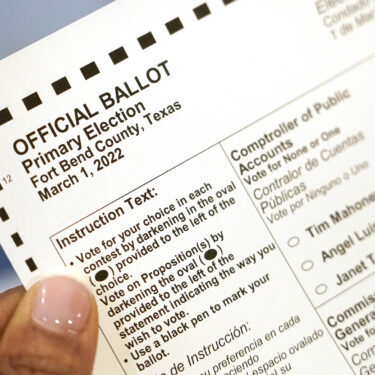Even before Texas held its first-in-the-nation primary of the 2022 midterms, reporter Paul Weber and his Austin colleague, Report for America fellow Acacia Coronado, knew they wanted to be the first journalists to tackle the numbers that would give the fullest picture yet of the impact of Republican voting restrictions enacted in the Lone Star State and elsewhere in the U.S.
When GOP lawmakers in multiple states passed stricter voting laws following the 2020 election — partly fueled by persistent false claims of widespread fraud in President Joe Biden’s victory — Democrats and voting rights activists said it would make America’s core democratic practice more difficult.
So as the March 1 primary came and went,Weber and Coronado immediately began tallying county-by-county to determine the total number of mail ballots flagged for rejection — most because voters were unfamiliar with new specific requirements for submitting ballots. With help from elections data reporter Aaron Kessler in Washington they were able to report,just one week after the primary,that more than 27,000 ballots were initially flagged for rejection,jeopardizing votes cast by Democrats and Republicans alike in counties big and small. That also put the rate of rejected mail ballots on track to significantly surpass previous Texas elections.
Reader response and customer play was immediate,including in the reporters’ own backyard,where the state capital’s own Austin American-Statesman published it above the fold in its print edition and The Dallas Morning News put it at the top of its morning newsletter.
But Weber and Coronado knew that voters still had time to fix flagged ballots,and that only a complete accounting would tell the full story. They also knew they needed assistance, which they received from nine colleagues around the country who jumped in to help contact all 254 Texas counties. Kessler ran multiple sets of numbers and cross-checked AP databases for the most accurate tallies.
Breaking AP exclusive: AUSTIN,Texas (AP) — AP review shows Texas rejected about 13% of mail ballots,nearly 23,000 total, in first election under new voting law. #txlege Our latest: https://t.co/ZMLKYxTEMP
— Acacia C (@acacia_coronado) March 16, 2022
The result? A follow-up piece just one week later in which the final numbers revealed a glaring discrepancy between the stated objective of those who promised the new voting rules would make it easier to vote and harder to cheat,and the reality of tens of thousands of uncounted votes. Roughly 13% of mail ballots were discarded and uncounted across 187 counties in Texas. While historical primary comparisons are lacking,experts say anything above 2% is usually cause for attention.
For setting the primary season tone with fast,ambitious and comprehensive work on the foundation of U.S. democracy — the right to vote — the team of Weber,Coronado and Kessler,with an assist from fellow reporters across the country, is AP’s Best of the Week — Second Winner.
Visit AP.org to request a trial subscription to AP’s video,photo and text services.
For breaking news, visit apnews.com




